Independent Research Project: Workers' Compensation & Productivity
VerifiedAdded on 2023/06/11
|27
|7044
|236
Report
AI Summary
This report investigates the impact of workers' injury compensation on employee productivity. It begins with a background and introduction to the research problem, purpose, aims, and objectives, highlighting the significance and scope of the study. The literature review explores concepts of workers' injury compensation, its characteristics, and its impact on employee productivity, drawing from expectancy, reinforcement, and agency theories. The research methodology employs a qualitative approach with primary data collection. The findings and discussion section analyzes the data collected, leading to recommendations for implementation and a conclusion summarizing the key insights. The report includes references and an appendix with an interview transcript, providing a comprehensive overview of the relationship between workers' compensation and employee productivity.
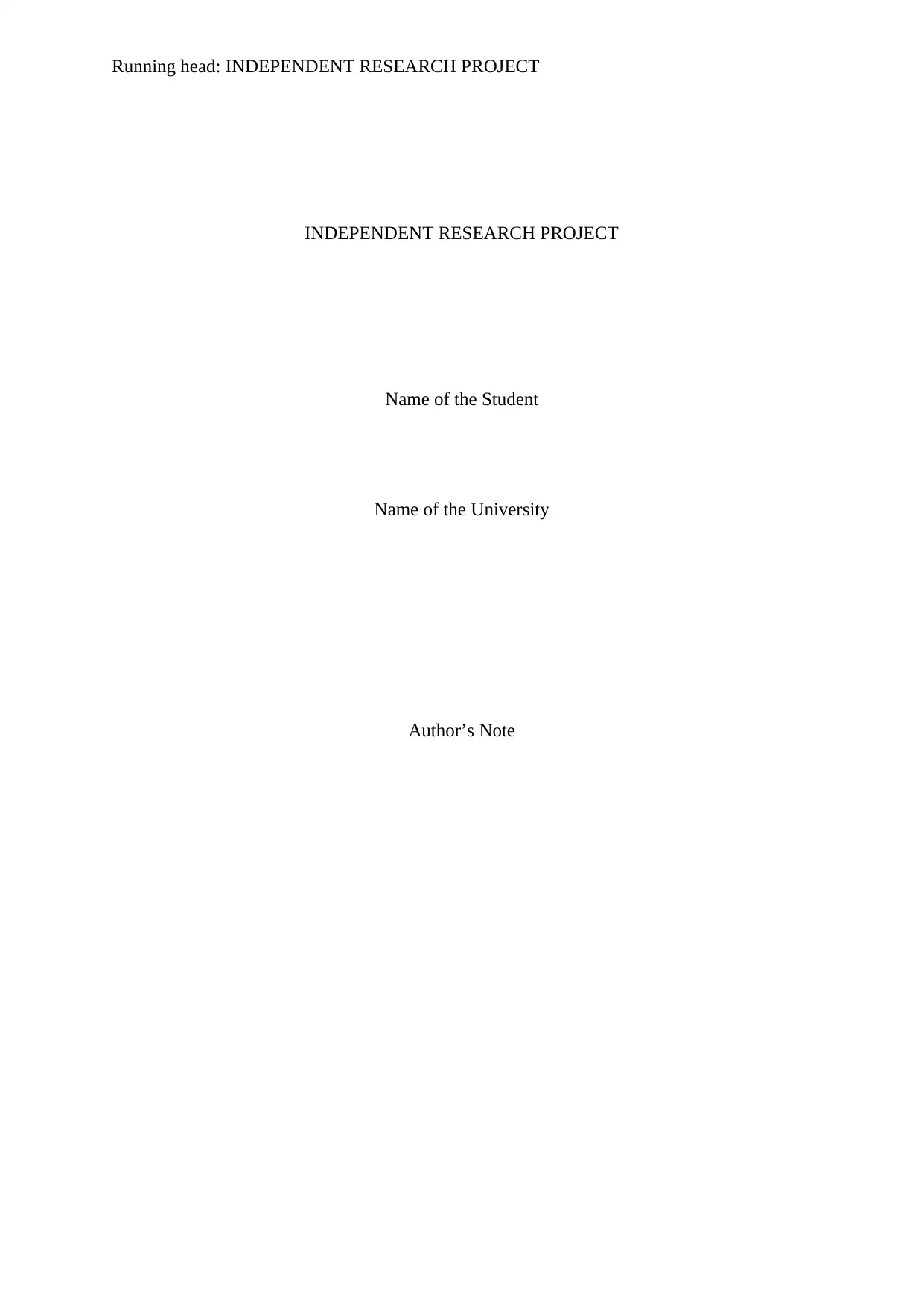
Running head: INDEPENDENT RESEARCH PROJECT
INDEPENDENT RESEARCH PROJECT
Name of the Student
Name of the University
Author’s Note
INDEPENDENT RESEARCH PROJECT
Name of the Student
Name of the University
Author’s Note
Paraphrase This Document
Need a fresh take? Get an instant paraphrase of this document with our AI Paraphraser
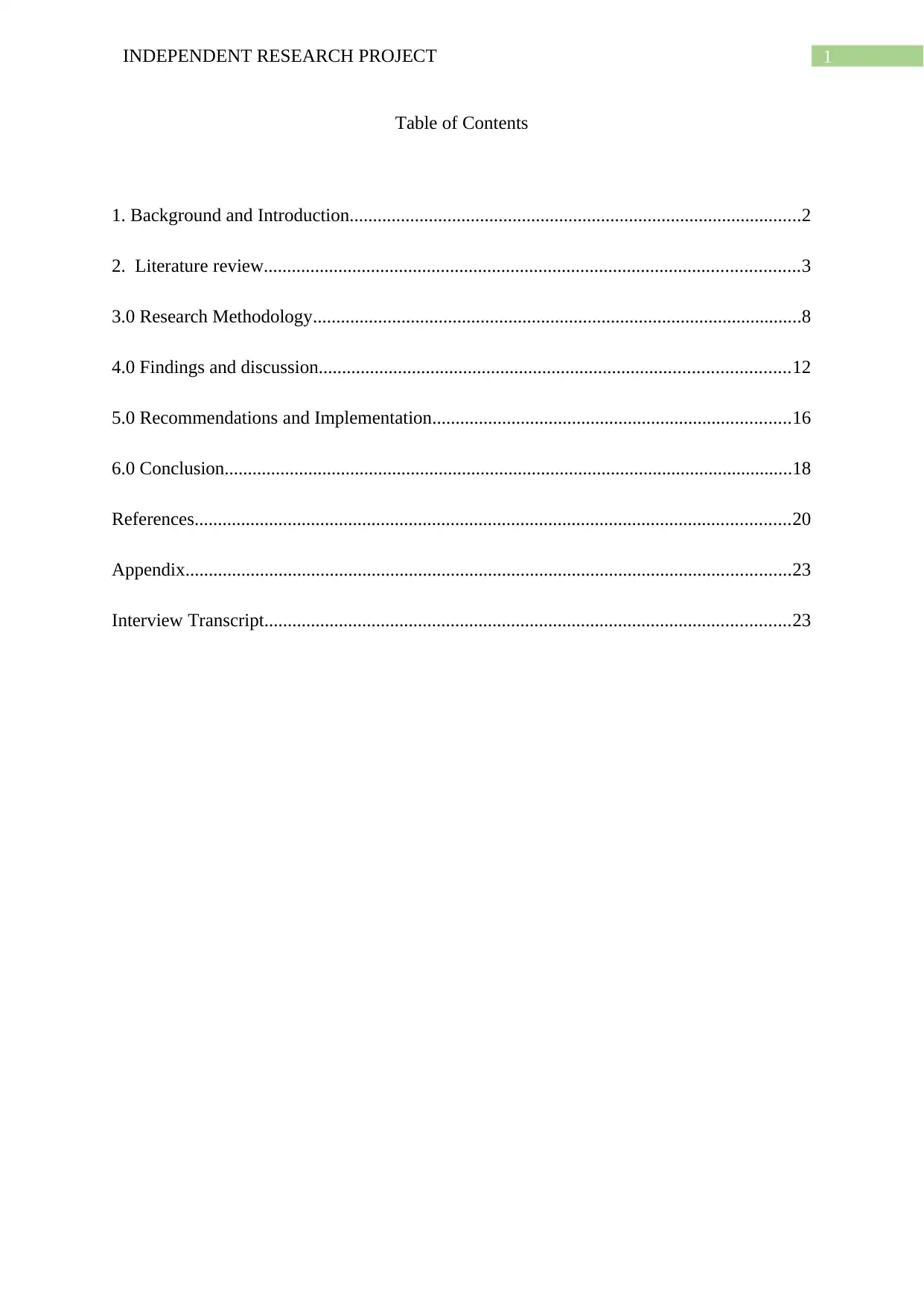
1INDEPENDENT RESEARCH PROJECT
Table of Contents
1. Background and Introduction.................................................................................................2
2. Literature review...................................................................................................................3
3.0 Research Methodology.........................................................................................................8
4.0 Findings and discussion.....................................................................................................12
5.0 Recommendations and Implementation.............................................................................16
6.0 Conclusion..........................................................................................................................18
References................................................................................................................................20
Appendix..................................................................................................................................23
Interview Transcript.................................................................................................................23
Table of Contents
1. Background and Introduction.................................................................................................2
2. Literature review...................................................................................................................3
3.0 Research Methodology.........................................................................................................8
4.0 Findings and discussion.....................................................................................................12
5.0 Recommendations and Implementation.............................................................................16
6.0 Conclusion..........................................................................................................................18
References................................................................................................................................20
Appendix..................................................................................................................................23
Interview Transcript.................................................................................................................23
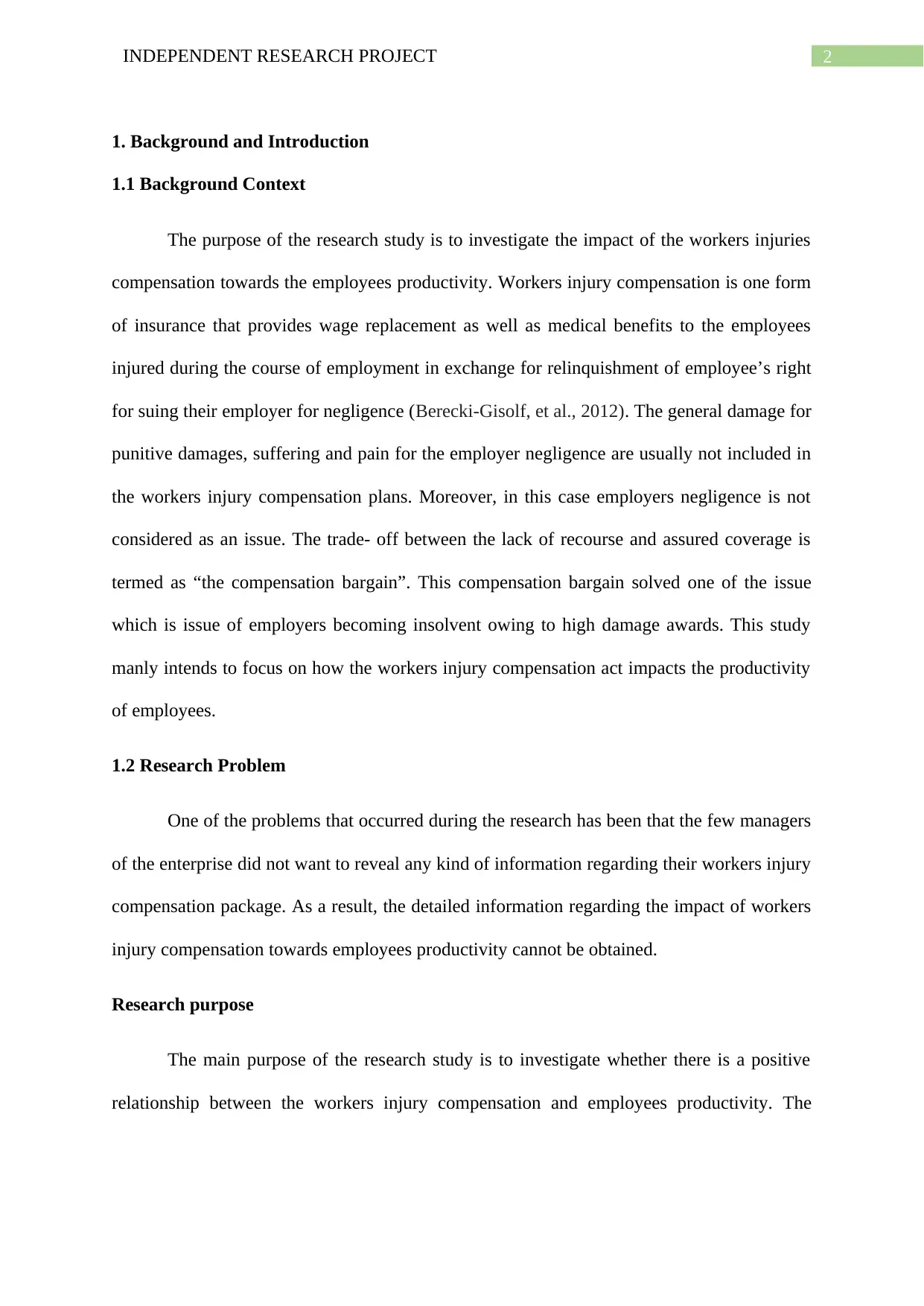
2INDEPENDENT RESEARCH PROJECT
1. Background and Introduction
1.1 Background Context
The purpose of the research study is to investigate the impact of the workers injuries
compensation towards the employees productivity. Workers injury compensation is one form
of insurance that provides wage replacement as well as medical benefits to the employees
injured during the course of employment in exchange for relinquishment of employee’s right
for suing their employer for negligence (Berecki-Gisolf, et al., 2012). The general damage for
punitive damages, suffering and pain for the employer negligence are usually not included in
the workers injury compensation plans. Moreover, in this case employers negligence is not
considered as an issue. The trade- off between the lack of recourse and assured coverage is
termed as “the compensation bargain”. This compensation bargain solved one of the issue
which is issue of employers becoming insolvent owing to high damage awards. This study
manly intends to focus on how the workers injury compensation act impacts the productivity
of employees.
1.2 Research Problem
One of the problems that occurred during the research has been that the few managers
of the enterprise did not want to reveal any kind of information regarding their workers injury
compensation package. As a result, the detailed information regarding the impact of workers
injury compensation towards employees productivity cannot be obtained.
Research purpose
The main purpose of the research study is to investigate whether there is a positive
relationship between the workers injury compensation and employees productivity. The
1. Background and Introduction
1.1 Background Context
The purpose of the research study is to investigate the impact of the workers injuries
compensation towards the employees productivity. Workers injury compensation is one form
of insurance that provides wage replacement as well as medical benefits to the employees
injured during the course of employment in exchange for relinquishment of employee’s right
for suing their employer for negligence (Berecki-Gisolf, et al., 2012). The general damage for
punitive damages, suffering and pain for the employer negligence are usually not included in
the workers injury compensation plans. Moreover, in this case employers negligence is not
considered as an issue. The trade- off between the lack of recourse and assured coverage is
termed as “the compensation bargain”. This compensation bargain solved one of the issue
which is issue of employers becoming insolvent owing to high damage awards. This study
manly intends to focus on how the workers injury compensation act impacts the productivity
of employees.
1.2 Research Problem
One of the problems that occurred during the research has been that the few managers
of the enterprise did not want to reveal any kind of information regarding their workers injury
compensation package. As a result, the detailed information regarding the impact of workers
injury compensation towards employees productivity cannot be obtained.
Research purpose
The main purpose of the research study is to investigate whether there is a positive
relationship between the workers injury compensation and employees productivity. The
⊘ This is a preview!⊘
Do you want full access?
Subscribe today to unlock all pages.

Trusted by 1+ million students worldwide
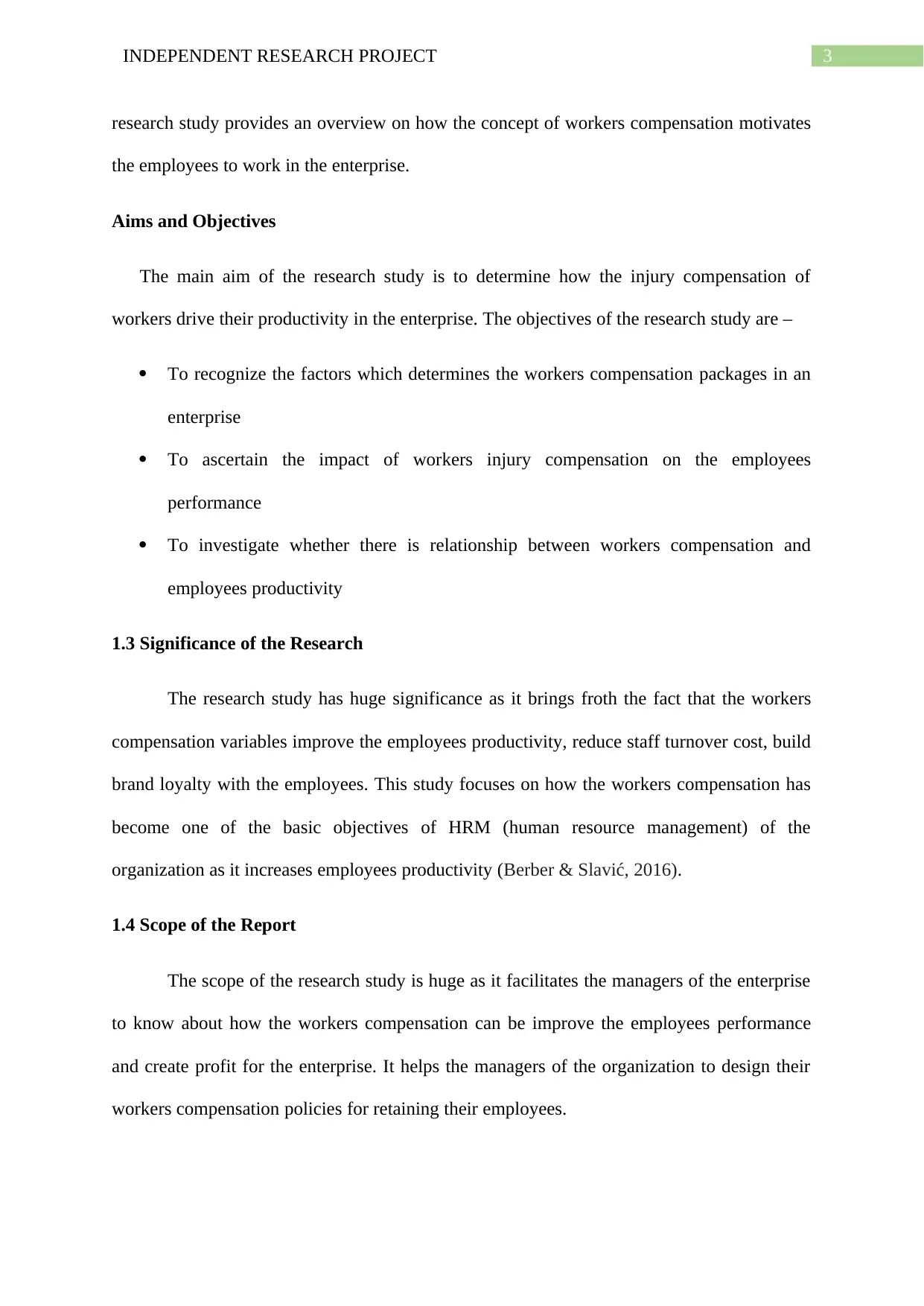
3INDEPENDENT RESEARCH PROJECT
research study provides an overview on how the concept of workers compensation motivates
the employees to work in the enterprise.
Aims and Objectives
The main aim of the research study is to determine how the injury compensation of
workers drive their productivity in the enterprise. The objectives of the research study are –
To recognize the factors which determines the workers compensation packages in an
enterprise
To ascertain the impact of workers injury compensation on the employees
performance
To investigate whether there is relationship between workers compensation and
employees productivity
1.3 Significance of the Research
The research study has huge significance as it brings froth the fact that the workers
compensation variables improve the employees productivity, reduce staff turnover cost, build
brand loyalty with the employees. This study focuses on how the workers compensation has
become one of the basic objectives of HRM (human resource management) of the
organization as it increases employees productivity (Berber & Slavić, 2016).
1.4 Scope of the Report
The scope of the research study is huge as it facilitates the managers of the enterprise
to know about how the workers compensation can be improve the employees performance
and create profit for the enterprise. It helps the managers of the organization to design their
workers compensation policies for retaining their employees.
research study provides an overview on how the concept of workers compensation motivates
the employees to work in the enterprise.
Aims and Objectives
The main aim of the research study is to determine how the injury compensation of
workers drive their productivity in the enterprise. The objectives of the research study are –
To recognize the factors which determines the workers compensation packages in an
enterprise
To ascertain the impact of workers injury compensation on the employees
performance
To investigate whether there is relationship between workers compensation and
employees productivity
1.3 Significance of the Research
The research study has huge significance as it brings froth the fact that the workers
compensation variables improve the employees productivity, reduce staff turnover cost, build
brand loyalty with the employees. This study focuses on how the workers compensation has
become one of the basic objectives of HRM (human resource management) of the
organization as it increases employees productivity (Berber & Slavić, 2016).
1.4 Scope of the Report
The scope of the research study is huge as it facilitates the managers of the enterprise
to know about how the workers compensation can be improve the employees performance
and create profit for the enterprise. It helps the managers of the organization to design their
workers compensation policies for retaining their employees.
Paraphrase This Document
Need a fresh take? Get an instant paraphrase of this document with our AI Paraphraser
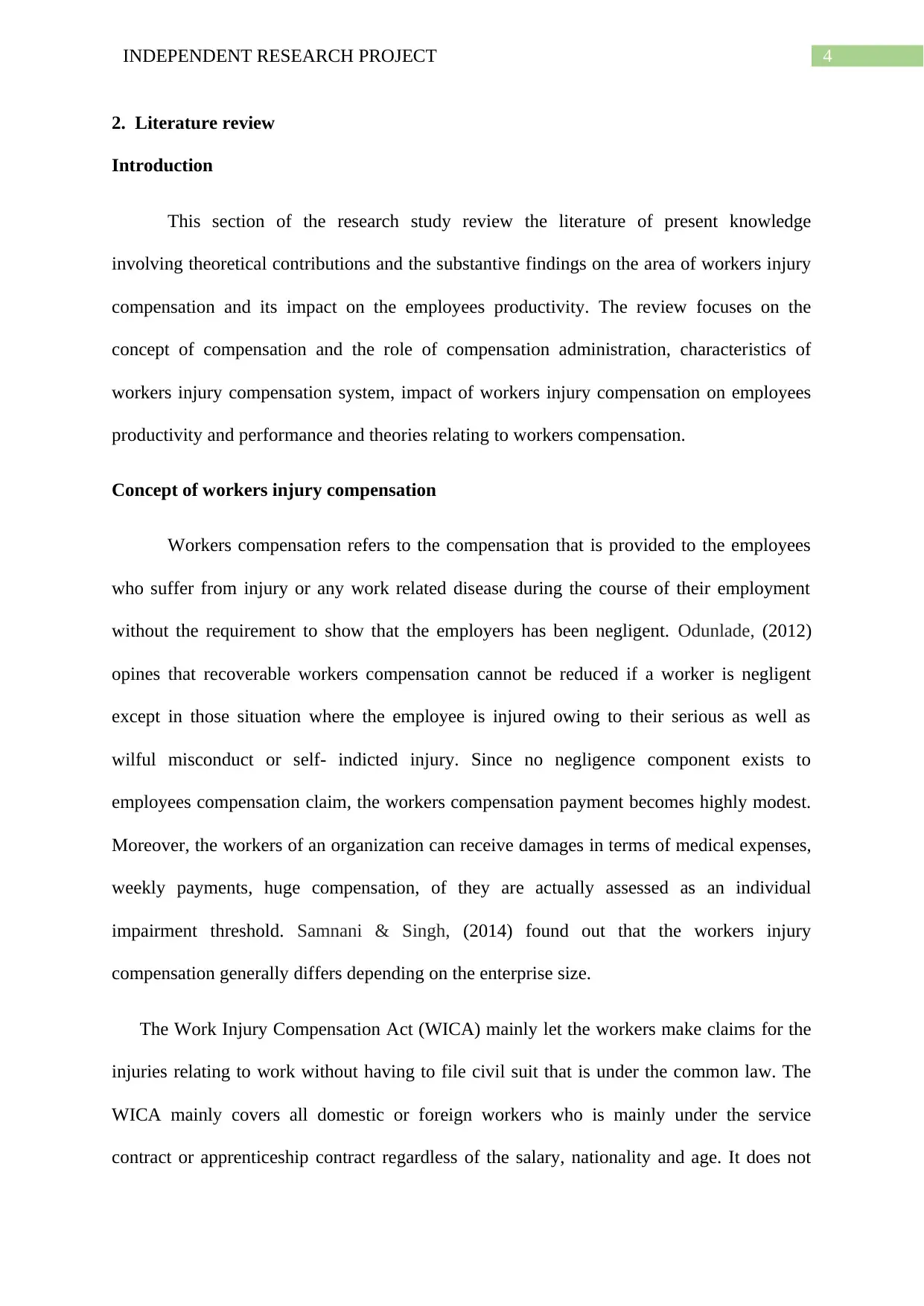
4INDEPENDENT RESEARCH PROJECT
2. Literature review
Introduction
This section of the research study review the literature of present knowledge
involving theoretical contributions and the substantive findings on the area of workers injury
compensation and its impact on the employees productivity. The review focuses on the
concept of compensation and the role of compensation administration, characteristics of
workers injury compensation system, impact of workers injury compensation on employees
productivity and performance and theories relating to workers compensation.
Concept of workers injury compensation
Workers compensation refers to the compensation that is provided to the employees
who suffer from injury or any work related disease during the course of their employment
without the requirement to show that the employers has been negligent. Odunlade, (2012)
opines that recoverable workers compensation cannot be reduced if a worker is negligent
except in those situation where the employee is injured owing to their serious as well as
wilful misconduct or self- indicted injury. Since no negligence component exists to
employees compensation claim, the workers compensation payment becomes highly modest.
Moreover, the workers of an organization can receive damages in terms of medical expenses,
weekly payments, huge compensation, of they are actually assessed as an individual
impairment threshold. Samnani & Singh, (2014) found out that the workers injury
compensation generally differs depending on the enterprise size.
The Work Injury Compensation Act (WICA) mainly let the workers make claims for the
injuries relating to work without having to file civil suit that is under the common law. The
WICA mainly covers all domestic or foreign workers who is mainly under the service
contract or apprenticeship contract regardless of the salary, nationality and age. It does not
2. Literature review
Introduction
This section of the research study review the literature of present knowledge
involving theoretical contributions and the substantive findings on the area of workers injury
compensation and its impact on the employees productivity. The review focuses on the
concept of compensation and the role of compensation administration, characteristics of
workers injury compensation system, impact of workers injury compensation on employees
productivity and performance and theories relating to workers compensation.
Concept of workers injury compensation
Workers compensation refers to the compensation that is provided to the employees
who suffer from injury or any work related disease during the course of their employment
without the requirement to show that the employers has been negligent. Odunlade, (2012)
opines that recoverable workers compensation cannot be reduced if a worker is negligent
except in those situation where the employee is injured owing to their serious as well as
wilful misconduct or self- indicted injury. Since no negligence component exists to
employees compensation claim, the workers compensation payment becomes highly modest.
Moreover, the workers of an organization can receive damages in terms of medical expenses,
weekly payments, huge compensation, of they are actually assessed as an individual
impairment threshold. Samnani & Singh, (2014) found out that the workers injury
compensation generally differs depending on the enterprise size.
The Work Injury Compensation Act (WICA) mainly let the workers make claims for the
injuries relating to work without having to file civil suit that is under the common law. The
WICA mainly covers all domestic or foreign workers who is mainly under the service
contract or apprenticeship contract regardless of the salary, nationality and age. It does not
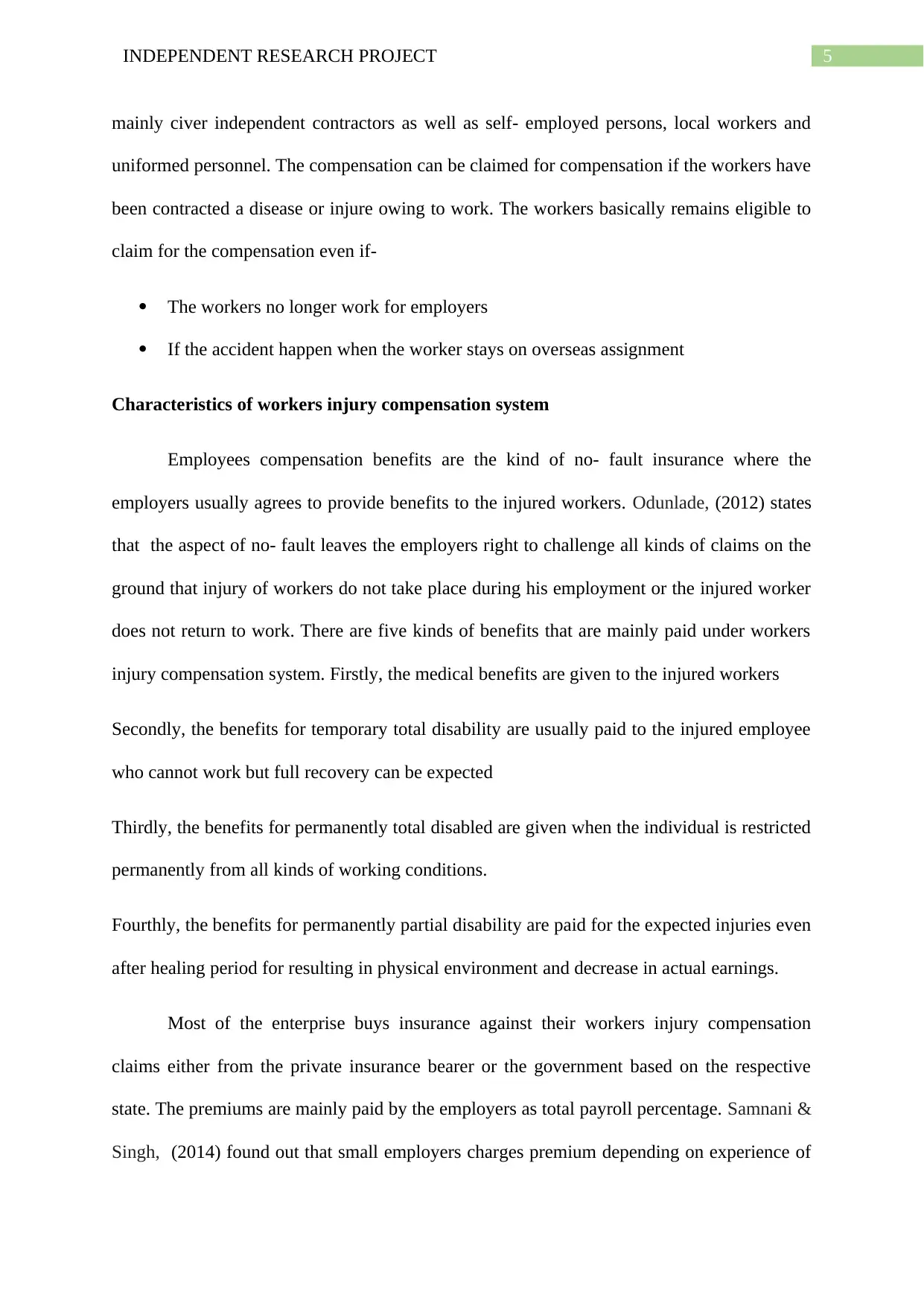
5INDEPENDENT RESEARCH PROJECT
mainly civer independent contractors as well as self- employed persons, local workers and
uniformed personnel. The compensation can be claimed for compensation if the workers have
been contracted a disease or injure owing to work. The workers basically remains eligible to
claim for the compensation even if-
The workers no longer work for employers
If the accident happen when the worker stays on overseas assignment
Characteristics of workers injury compensation system
Employees compensation benefits are the kind of no- fault insurance where the
employers usually agrees to provide benefits to the injured workers. Odunlade, (2012) states
that the aspect of no- fault leaves the employers right to challenge all kinds of claims on the
ground that injury of workers do not take place during his employment or the injured worker
does not return to work. There are five kinds of benefits that are mainly paid under workers
injury compensation system. Firstly, the medical benefits are given to the injured workers
Secondly, the benefits for temporary total disability are usually paid to the injured employee
who cannot work but full recovery can be expected
Thirdly, the benefits for permanently total disabled are given when the individual is restricted
permanently from all kinds of working conditions.
Fourthly, the benefits for permanently partial disability are paid for the expected injuries even
after healing period for resulting in physical environment and decrease in actual earnings.
Most of the enterprise buys insurance against their workers injury compensation
claims either from the private insurance bearer or the government based on the respective
state. The premiums are mainly paid by the employers as total payroll percentage. Samnani &
Singh, (2014) found out that small employers charges premium depending on experience of
mainly civer independent contractors as well as self- employed persons, local workers and
uniformed personnel. The compensation can be claimed for compensation if the workers have
been contracted a disease or injure owing to work. The workers basically remains eligible to
claim for the compensation even if-
The workers no longer work for employers
If the accident happen when the worker stays on overseas assignment
Characteristics of workers injury compensation system
Employees compensation benefits are the kind of no- fault insurance where the
employers usually agrees to provide benefits to the injured workers. Odunlade, (2012) states
that the aspect of no- fault leaves the employers right to challenge all kinds of claims on the
ground that injury of workers do not take place during his employment or the injured worker
does not return to work. There are five kinds of benefits that are mainly paid under workers
injury compensation system. Firstly, the medical benefits are given to the injured workers
Secondly, the benefits for temporary total disability are usually paid to the injured employee
who cannot work but full recovery can be expected
Thirdly, the benefits for permanently total disabled are given when the individual is restricted
permanently from all kinds of working conditions.
Fourthly, the benefits for permanently partial disability are paid for the expected injuries even
after healing period for resulting in physical environment and decrease in actual earnings.
Most of the enterprise buys insurance against their workers injury compensation
claims either from the private insurance bearer or the government based on the respective
state. The premiums are mainly paid by the employers as total payroll percentage. Samnani &
Singh, (2014) found out that small employers charges premium depending on experience of
⊘ This is a preview!⊘
Do you want full access?
Subscribe today to unlock all pages.

Trusted by 1+ million students worldwide
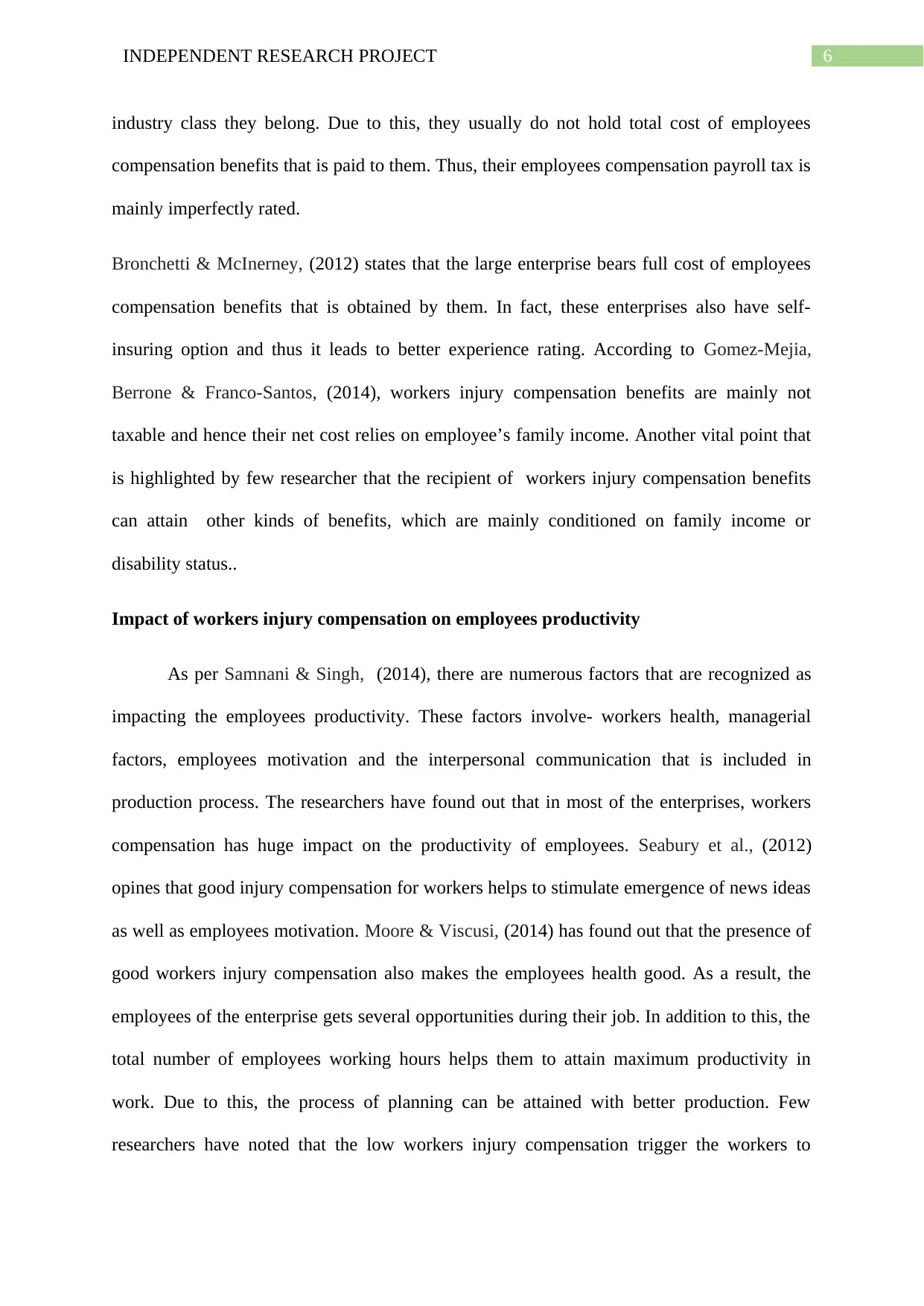
6INDEPENDENT RESEARCH PROJECT
industry class they belong. Due to this, they usually do not hold total cost of employees
compensation benefits that is paid to them. Thus, their employees compensation payroll tax is
mainly imperfectly rated.
Bronchetti & McInerney, (2012) states that the large enterprise bears full cost of employees
compensation benefits that is obtained by them. In fact, these enterprises also have self-
insuring option and thus it leads to better experience rating. According to Gomez-Mejia,
Berrone & Franco-Santos, (2014), workers injury compensation benefits are mainly not
taxable and hence their net cost relies on employee’s family income. Another vital point that
is highlighted by few researcher that the recipient of workers injury compensation benefits
can attain other kinds of benefits, which are mainly conditioned on family income or
disability status..
Impact of workers injury compensation on employees productivity
As per Samnani & Singh, (2014), there are numerous factors that are recognized as
impacting the employees productivity. These factors involve- workers health, managerial
factors, employees motivation and the interpersonal communication that is included in
production process. The researchers have found out that in most of the enterprises, workers
compensation has huge impact on the productivity of employees. Seabury et al., (2012)
opines that good injury compensation for workers helps to stimulate emergence of news ideas
as well as employees motivation. Moore & Viscusi, (2014) has found out that the presence of
good workers injury compensation also makes the employees health good. As a result, the
employees of the enterprise gets several opportunities during their job. In addition to this, the
total number of employees working hours helps them to attain maximum productivity in
work. Due to this, the process of planning can be attained with better production. Few
researchers have noted that the low workers injury compensation trigger the workers to
industry class they belong. Due to this, they usually do not hold total cost of employees
compensation benefits that is paid to them. Thus, their employees compensation payroll tax is
mainly imperfectly rated.
Bronchetti & McInerney, (2012) states that the large enterprise bears full cost of employees
compensation benefits that is obtained by them. In fact, these enterprises also have self-
insuring option and thus it leads to better experience rating. According to Gomez-Mejia,
Berrone & Franco-Santos, (2014), workers injury compensation benefits are mainly not
taxable and hence their net cost relies on employee’s family income. Another vital point that
is highlighted by few researcher that the recipient of workers injury compensation benefits
can attain other kinds of benefits, which are mainly conditioned on family income or
disability status..
Impact of workers injury compensation on employees productivity
As per Samnani & Singh, (2014), there are numerous factors that are recognized as
impacting the employees productivity. These factors involve- workers health, managerial
factors, employees motivation and the interpersonal communication that is included in
production process. The researchers have found out that in most of the enterprises, workers
compensation has huge impact on the productivity of employees. Seabury et al., (2012)
opines that good injury compensation for workers helps to stimulate emergence of news ideas
as well as employees motivation. Moore & Viscusi, (2014) has found out that the presence of
good workers injury compensation also makes the employees health good. As a result, the
employees of the enterprise gets several opportunities during their job. In addition to this, the
total number of employees working hours helps them to attain maximum productivity in
work. Due to this, the process of planning can be attained with better production. Few
researchers have noted that the low workers injury compensation trigger the workers to
Paraphrase This Document
Need a fresh take? Get an instant paraphrase of this document with our AI Paraphraser
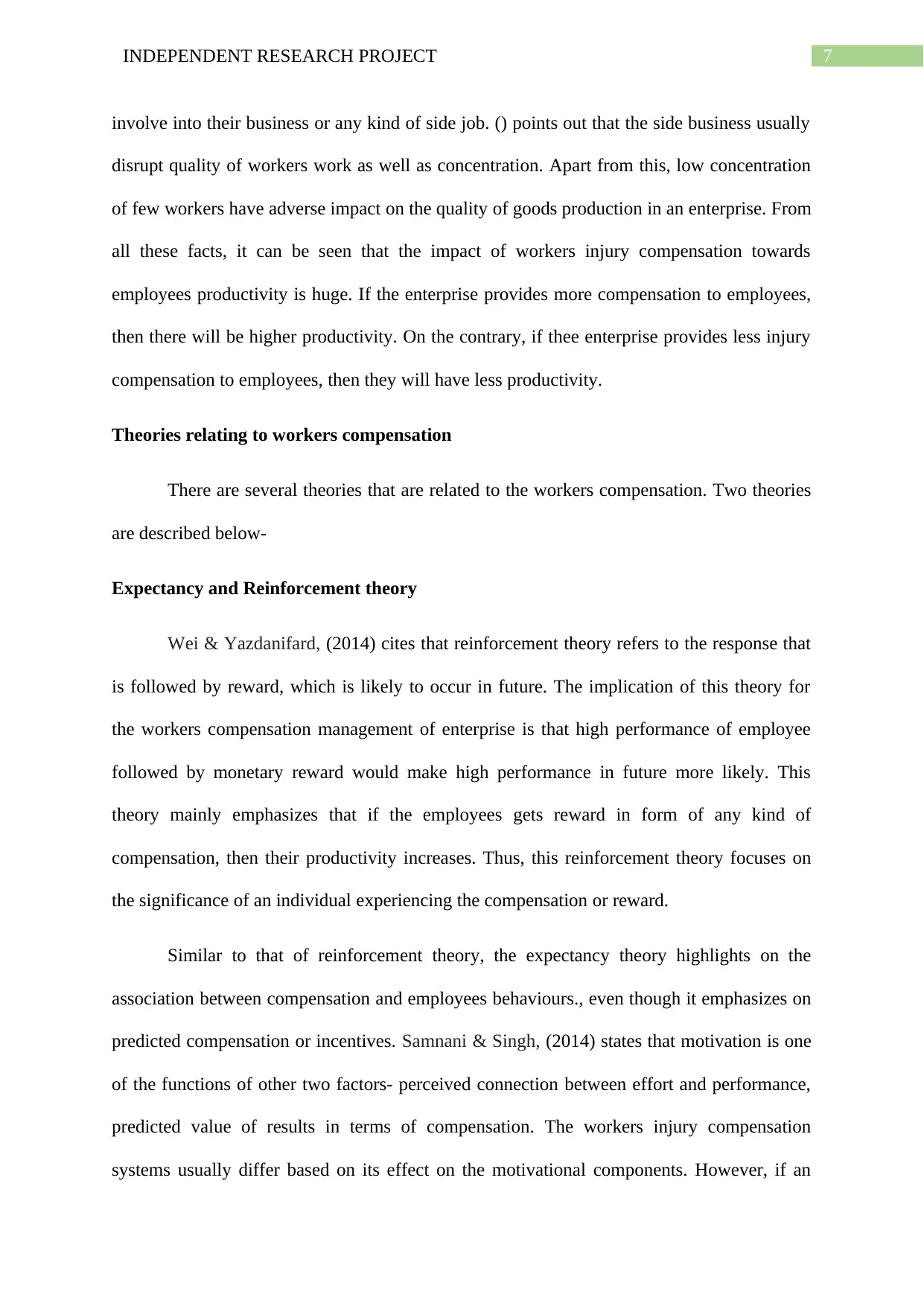
7INDEPENDENT RESEARCH PROJECT
involve into their business or any kind of side job. () points out that the side business usually
disrupt quality of workers work as well as concentration. Apart from this, low concentration
of few workers have adverse impact on the quality of goods production in an enterprise. From
all these facts, it can be seen that the impact of workers injury compensation towards
employees productivity is huge. If the enterprise provides more compensation to employees,
then there will be higher productivity. On the contrary, if thee enterprise provides less injury
compensation to employees, then they will have less productivity.
Theories relating to workers compensation
There are several theories that are related to the workers compensation. Two theories
are described below-
Expectancy and Reinforcement theory
Wei & Yazdanifard, (2014) cites that reinforcement theory refers to the response that
is followed by reward, which is likely to occur in future. The implication of this theory for
the workers compensation management of enterprise is that high performance of employee
followed by monetary reward would make high performance in future more likely. This
theory mainly emphasizes that if the employees gets reward in form of any kind of
compensation, then their productivity increases. Thus, this reinforcement theory focuses on
the significance of an individual experiencing the compensation or reward.
Similar to that of reinforcement theory, the expectancy theory highlights on the
association between compensation and employees behaviours., even though it emphasizes on
predicted compensation or incentives. Samnani & Singh, (2014) states that motivation is one
of the functions of other two factors- perceived connection between effort and performance,
predicted value of results in terms of compensation. The workers injury compensation
systems usually differ based on its effect on the motivational components. However, if an
involve into their business or any kind of side job. () points out that the side business usually
disrupt quality of workers work as well as concentration. Apart from this, low concentration
of few workers have adverse impact on the quality of goods production in an enterprise. From
all these facts, it can be seen that the impact of workers injury compensation towards
employees productivity is huge. If the enterprise provides more compensation to employees,
then there will be higher productivity. On the contrary, if thee enterprise provides less injury
compensation to employees, then they will have less productivity.
Theories relating to workers compensation
There are several theories that are related to the workers compensation. Two theories
are described below-
Expectancy and Reinforcement theory
Wei & Yazdanifard, (2014) cites that reinforcement theory refers to the response that
is followed by reward, which is likely to occur in future. The implication of this theory for
the workers compensation management of enterprise is that high performance of employee
followed by monetary reward would make high performance in future more likely. This
theory mainly emphasizes that if the employees gets reward in form of any kind of
compensation, then their productivity increases. Thus, this reinforcement theory focuses on
the significance of an individual experiencing the compensation or reward.
Similar to that of reinforcement theory, the expectancy theory highlights on the
association between compensation and employees behaviours., even though it emphasizes on
predicted compensation or incentives. Samnani & Singh, (2014) states that motivation is one
of the functions of other two factors- perceived connection between effort and performance,
predicted value of results in terms of compensation. The workers injury compensation
systems usually differ based on its effect on the motivational components. However, if an
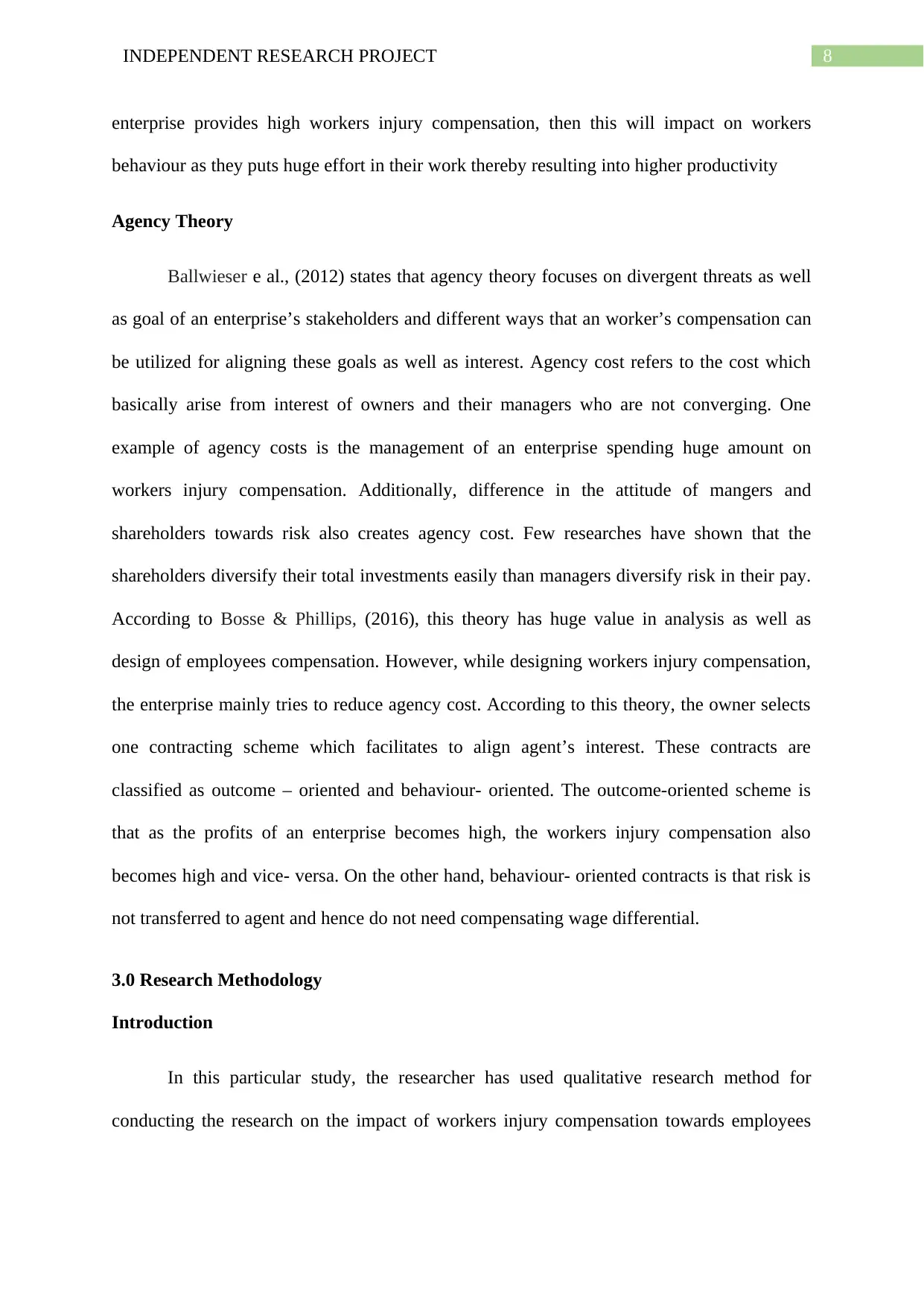
8INDEPENDENT RESEARCH PROJECT
enterprise provides high workers injury compensation, then this will impact on workers
behaviour as they puts huge effort in their work thereby resulting into higher productivity
Agency Theory
Ballwieser e al., (2012) states that agency theory focuses on divergent threats as well
as goal of an enterprise’s stakeholders and different ways that an worker’s compensation can
be utilized for aligning these goals as well as interest. Agency cost refers to the cost which
basically arise from interest of owners and their managers who are not converging. One
example of agency costs is the management of an enterprise spending huge amount on
workers injury compensation. Additionally, difference in the attitude of mangers and
shareholders towards risk also creates agency cost. Few researches have shown that the
shareholders diversify their total investments easily than managers diversify risk in their pay.
According to Bosse & Phillips, (2016), this theory has huge value in analysis as well as
design of employees compensation. However, while designing workers injury compensation,
the enterprise mainly tries to reduce agency cost. According to this theory, the owner selects
one contracting scheme which facilitates to align agent’s interest. These contracts are
classified as outcome – oriented and behaviour- oriented. The outcome-oriented scheme is
that as the profits of an enterprise becomes high, the workers injury compensation also
becomes high and vice- versa. On the other hand, behaviour- oriented contracts is that risk is
not transferred to agent and hence do not need compensating wage differential.
3.0 Research Methodology
Introduction
In this particular study, the researcher has used qualitative research method for
conducting the research on the impact of workers injury compensation towards employees
enterprise provides high workers injury compensation, then this will impact on workers
behaviour as they puts huge effort in their work thereby resulting into higher productivity
Agency Theory
Ballwieser e al., (2012) states that agency theory focuses on divergent threats as well
as goal of an enterprise’s stakeholders and different ways that an worker’s compensation can
be utilized for aligning these goals as well as interest. Agency cost refers to the cost which
basically arise from interest of owners and their managers who are not converging. One
example of agency costs is the management of an enterprise spending huge amount on
workers injury compensation. Additionally, difference in the attitude of mangers and
shareholders towards risk also creates agency cost. Few researches have shown that the
shareholders diversify their total investments easily than managers diversify risk in their pay.
According to Bosse & Phillips, (2016), this theory has huge value in analysis as well as
design of employees compensation. However, while designing workers injury compensation,
the enterprise mainly tries to reduce agency cost. According to this theory, the owner selects
one contracting scheme which facilitates to align agent’s interest. These contracts are
classified as outcome – oriented and behaviour- oriented. The outcome-oriented scheme is
that as the profits of an enterprise becomes high, the workers injury compensation also
becomes high and vice- versa. On the other hand, behaviour- oriented contracts is that risk is
not transferred to agent and hence do not need compensating wage differential.
3.0 Research Methodology
Introduction
In this particular study, the researcher has used qualitative research method for
conducting the research on the impact of workers injury compensation towards employees
⊘ This is a preview!⊘
Do you want full access?
Subscribe today to unlock all pages.

Trusted by 1+ million students worldwide
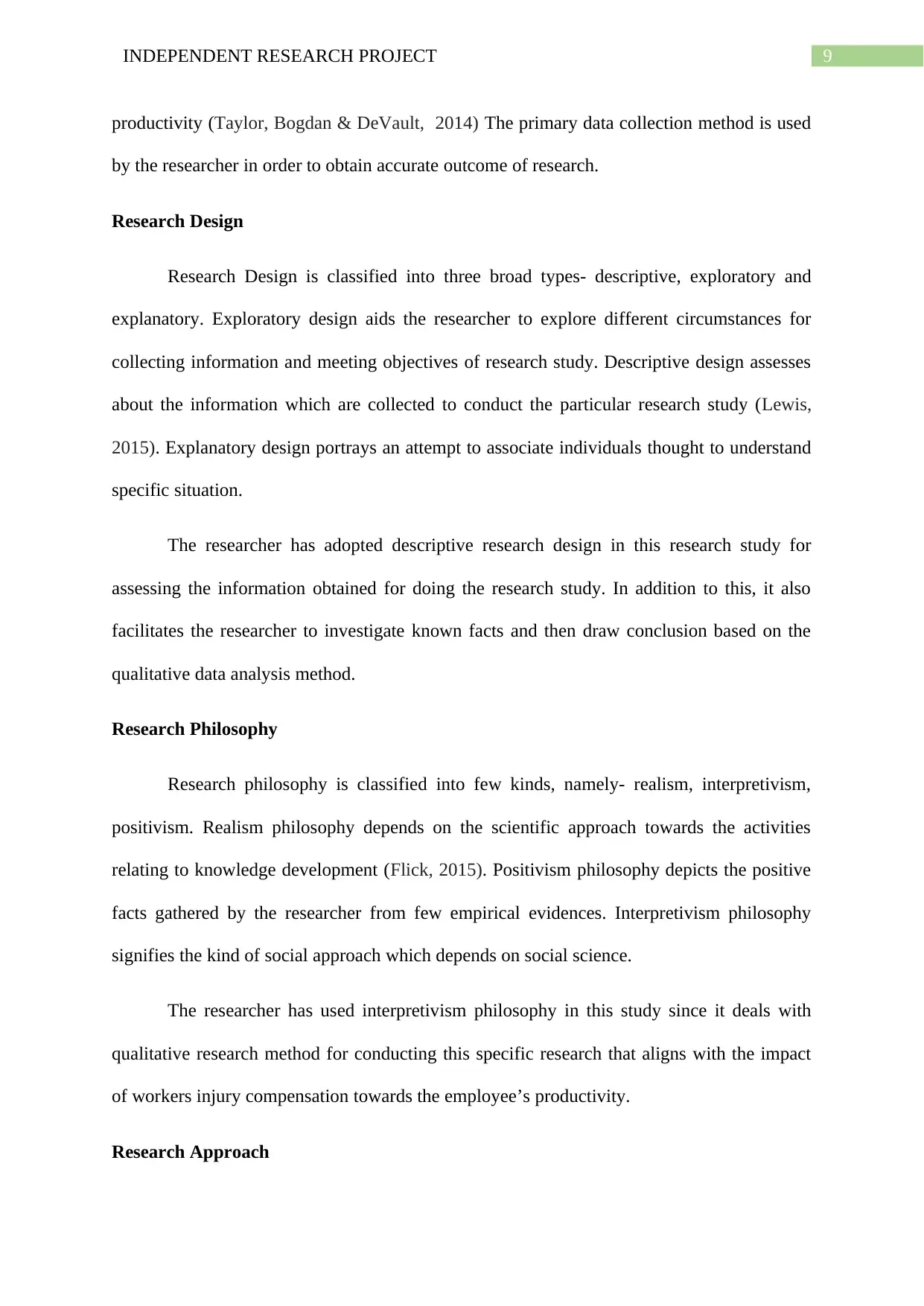
9INDEPENDENT RESEARCH PROJECT
productivity (Taylor, Bogdan & DeVault, 2014) The primary data collection method is used
by the researcher in order to obtain accurate outcome of research.
Research Design
Research Design is classified into three broad types- descriptive, exploratory and
explanatory. Exploratory design aids the researcher to explore different circumstances for
collecting information and meeting objectives of research study. Descriptive design assesses
about the information which are collected to conduct the particular research study (Lewis,
2015). Explanatory design portrays an attempt to associate individuals thought to understand
specific situation.
The researcher has adopted descriptive research design in this research study for
assessing the information obtained for doing the research study. In addition to this, it also
facilitates the researcher to investigate known facts and then draw conclusion based on the
qualitative data analysis method.
Research Philosophy
Research philosophy is classified into few kinds, namely- realism, interpretivism,
positivism. Realism philosophy depends on the scientific approach towards the activities
relating to knowledge development (Flick, 2015). Positivism philosophy depicts the positive
facts gathered by the researcher from few empirical evidences. Interpretivism philosophy
signifies the kind of social approach which depends on social science.
The researcher has used interpretivism philosophy in this study since it deals with
qualitative research method for conducting this specific research that aligns with the impact
of workers injury compensation towards the employee’s productivity.
Research Approach
productivity (Taylor, Bogdan & DeVault, 2014) The primary data collection method is used
by the researcher in order to obtain accurate outcome of research.
Research Design
Research Design is classified into three broad types- descriptive, exploratory and
explanatory. Exploratory design aids the researcher to explore different circumstances for
collecting information and meeting objectives of research study. Descriptive design assesses
about the information which are collected to conduct the particular research study (Lewis,
2015). Explanatory design portrays an attempt to associate individuals thought to understand
specific situation.
The researcher has adopted descriptive research design in this research study for
assessing the information obtained for doing the research study. In addition to this, it also
facilitates the researcher to investigate known facts and then draw conclusion based on the
qualitative data analysis method.
Research Philosophy
Research philosophy is classified into few kinds, namely- realism, interpretivism,
positivism. Realism philosophy depends on the scientific approach towards the activities
relating to knowledge development (Flick, 2015). Positivism philosophy depicts the positive
facts gathered by the researcher from few empirical evidences. Interpretivism philosophy
signifies the kind of social approach which depends on social science.
The researcher has used interpretivism philosophy in this study since it deals with
qualitative research method for conducting this specific research that aligns with the impact
of workers injury compensation towards the employee’s productivity.
Research Approach
Paraphrase This Document
Need a fresh take? Get an instant paraphrase of this document with our AI Paraphraser
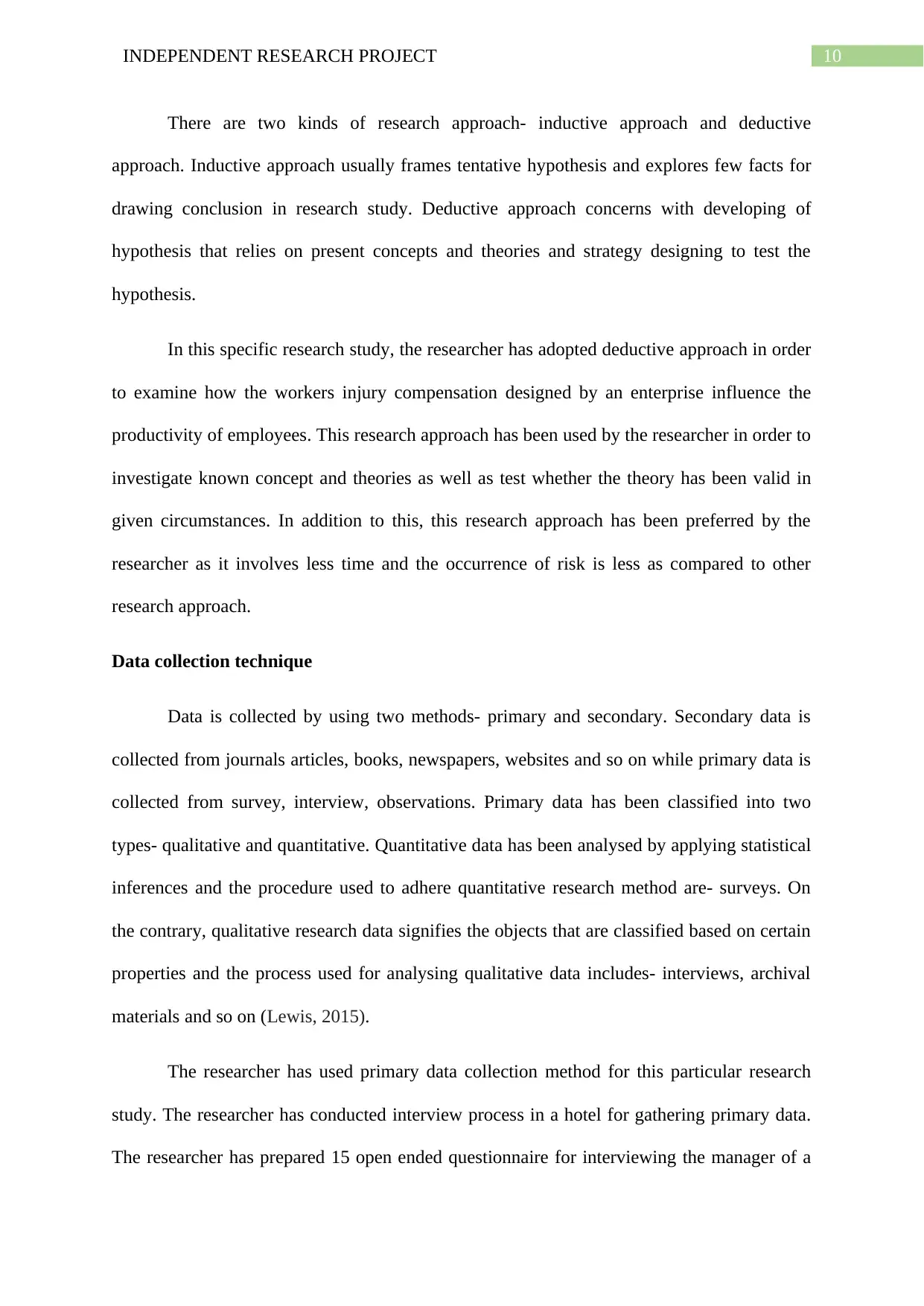
10INDEPENDENT RESEARCH PROJECT
There are two kinds of research approach- inductive approach and deductive
approach. Inductive approach usually frames tentative hypothesis and explores few facts for
drawing conclusion in research study. Deductive approach concerns with developing of
hypothesis that relies on present concepts and theories and strategy designing to test the
hypothesis.
In this specific research study, the researcher has adopted deductive approach in order
to examine how the workers injury compensation designed by an enterprise influence the
productivity of employees. This research approach has been used by the researcher in order to
investigate known concept and theories as well as test whether the theory has been valid in
given circumstances. In addition to this, this research approach has been preferred by the
researcher as it involves less time and the occurrence of risk is less as compared to other
research approach.
Data collection technique
Data is collected by using two methods- primary and secondary. Secondary data is
collected from journals articles, books, newspapers, websites and so on while primary data is
collected from survey, interview, observations. Primary data has been classified into two
types- qualitative and quantitative. Quantitative data has been analysed by applying statistical
inferences and the procedure used to adhere quantitative research method are- surveys. On
the contrary, qualitative research data signifies the objects that are classified based on certain
properties and the process used for analysing qualitative data includes- interviews, archival
materials and so on (Lewis, 2015).
The researcher has used primary data collection method for this particular research
study. The researcher has conducted interview process in a hotel for gathering primary data.
The researcher has prepared 15 open ended questionnaire for interviewing the manager of a
There are two kinds of research approach- inductive approach and deductive
approach. Inductive approach usually frames tentative hypothesis and explores few facts for
drawing conclusion in research study. Deductive approach concerns with developing of
hypothesis that relies on present concepts and theories and strategy designing to test the
hypothesis.
In this specific research study, the researcher has adopted deductive approach in order
to examine how the workers injury compensation designed by an enterprise influence the
productivity of employees. This research approach has been used by the researcher in order to
investigate known concept and theories as well as test whether the theory has been valid in
given circumstances. In addition to this, this research approach has been preferred by the
researcher as it involves less time and the occurrence of risk is less as compared to other
research approach.
Data collection technique
Data is collected by using two methods- primary and secondary. Secondary data is
collected from journals articles, books, newspapers, websites and so on while primary data is
collected from survey, interview, observations. Primary data has been classified into two
types- qualitative and quantitative. Quantitative data has been analysed by applying statistical
inferences and the procedure used to adhere quantitative research method are- surveys. On
the contrary, qualitative research data signifies the objects that are classified based on certain
properties and the process used for analysing qualitative data includes- interviews, archival
materials and so on (Lewis, 2015).
The researcher has used primary data collection method for this particular research
study. The researcher has conducted interview process in a hotel for gathering primary data.
The researcher has prepared 15 open ended questionnaire for interviewing the manager of a
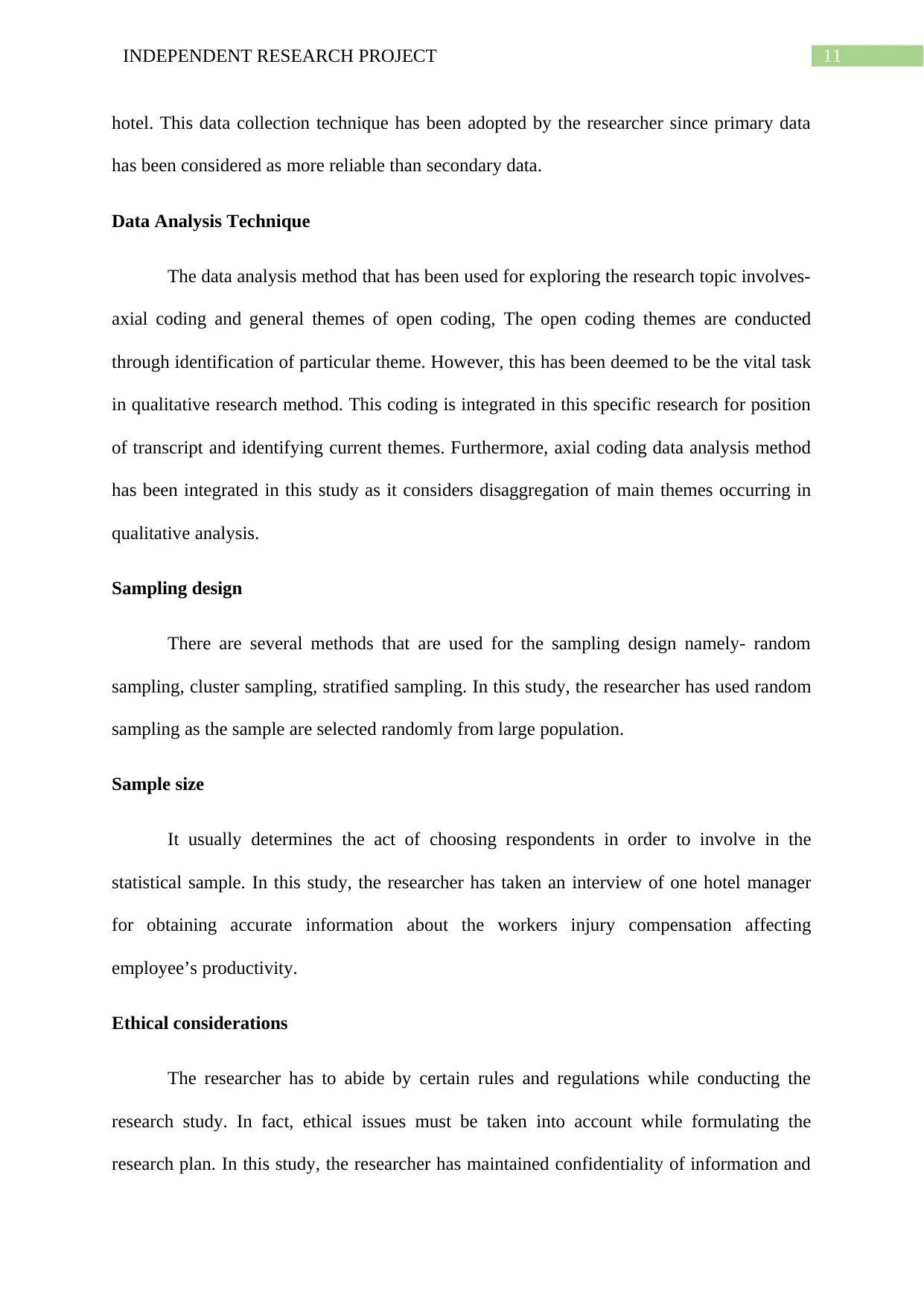
11INDEPENDENT RESEARCH PROJECT
hotel. This data collection technique has been adopted by the researcher since primary data
has been considered as more reliable than secondary data.
Data Analysis Technique
The data analysis method that has been used for exploring the research topic involves-
axial coding and general themes of open coding, The open coding themes are conducted
through identification of particular theme. However, this has been deemed to be the vital task
in qualitative research method. This coding is integrated in this specific research for position
of transcript and identifying current themes. Furthermore, axial coding data analysis method
has been integrated in this study as it considers disaggregation of main themes occurring in
qualitative analysis.
Sampling design
There are several methods that are used for the sampling design namely- random
sampling, cluster sampling, stratified sampling. In this study, the researcher has used random
sampling as the sample are selected randomly from large population.
Sample size
It usually determines the act of choosing respondents in order to involve in the
statistical sample. In this study, the researcher has taken an interview of one hotel manager
for obtaining accurate information about the workers injury compensation affecting
employee’s productivity.
Ethical considerations
The researcher has to abide by certain rules and regulations while conducting the
research study. In fact, ethical issues must be taken into account while formulating the
research plan. In this study, the researcher has maintained confidentiality of information and
hotel. This data collection technique has been adopted by the researcher since primary data
has been considered as more reliable than secondary data.
Data Analysis Technique
The data analysis method that has been used for exploring the research topic involves-
axial coding and general themes of open coding, The open coding themes are conducted
through identification of particular theme. However, this has been deemed to be the vital task
in qualitative research method. This coding is integrated in this specific research for position
of transcript and identifying current themes. Furthermore, axial coding data analysis method
has been integrated in this study as it considers disaggregation of main themes occurring in
qualitative analysis.
Sampling design
There are several methods that are used for the sampling design namely- random
sampling, cluster sampling, stratified sampling. In this study, the researcher has used random
sampling as the sample are selected randomly from large population.
Sample size
It usually determines the act of choosing respondents in order to involve in the
statistical sample. In this study, the researcher has taken an interview of one hotel manager
for obtaining accurate information about the workers injury compensation affecting
employee’s productivity.
Ethical considerations
The researcher has to abide by certain rules and regulations while conducting the
research study. In fact, ethical issues must be taken into account while formulating the
research plan. In this study, the researcher has maintained confidentiality of information and
⊘ This is a preview!⊘
Do you want full access?
Subscribe today to unlock all pages.

Trusted by 1+ million students worldwide
1 out of 27
Related Documents
Your All-in-One AI-Powered Toolkit for Academic Success.
+13062052269
info@desklib.com
Available 24*7 on WhatsApp / Email
![[object Object]](/_next/static/media/star-bottom.7253800d.svg)
Unlock your academic potential
Copyright © 2020–2025 A2Z Services. All Rights Reserved. Developed and managed by ZUCOL.





